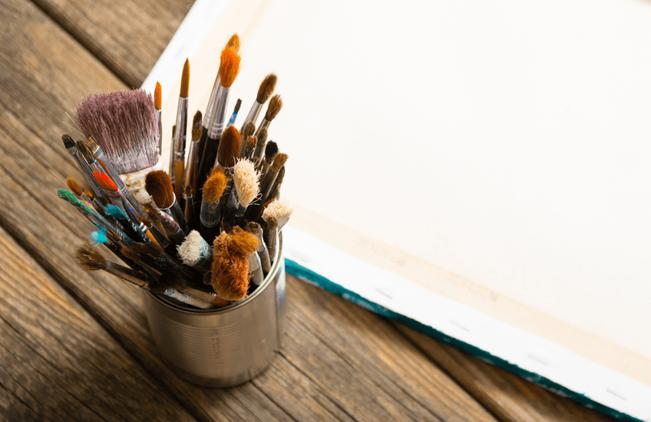Diving into the world of painting can be exciting and intimidating at the same time. Whether you’re dreaming of creating a masterpiece or just looking to explore a new hobby, getting started with the right tips and tools is an excellent first step. This guide will walk you through the basics to help you find your artistic groove. From choosing your brushes to mixing your colours, here’s everything you need to kickstart your creative journey.
Choosing Your Materials

Paints
Choosing the right paints is key to starting your painting journey. First, you need to decide between acrylics, watercolours, and oils based on your preference and style. Acrylics dry fast and are versatile, watercolours offer transparency and are easy to clean up, while oils provide rich textures but take longer to dry. Look for high-quality, artist-grade paints for better pigmentation and longevity. Start with primary colours—red, blue, and yellow—along with white and black, to mix a wide range of hues. Test different brands to find one that suits your technique and budget.
Brushes
Equipping yourself with the right brushes is vital for making your creative experience enjoyable. Here’s what you need to know about selecting the ideal artist paintbrushes for your artwork.
For beginners, there are three main types of paint brushes to consider: flat, round, and filbert. Flat brushes are great for bold, sweeping strokes and creating sharp edges. Round brushes, with their pointed tips, are versatile for detailed work and fine lines. Filbert brushes combine features of flat and round brushes, offering a versatile shape perfect for blending and curved strokes.
Quality is key when it comes to brushes. Look for brushes made with high-quality synthetic or natural bristles. Synthetic bristles are durable and often less expensive, while natural bristles (like sable or hog hair) can offer superior performance for specific techniques. A well-made brush will have a solid handle, a good balance, and a neatly crimped ferrule (the metal part that holds the bristles).
One common issue with cheaper brushes is loose ferrules. If the ferrule isn’t securely attached, bristles can fall out, ruining your painting experience. Stray bristles can also be problematic, as they can cause unwanted marks or affect the precision of your work. Always check the brush before purchasing to ensure the ferrule is tightly secured and the bristles are intact.
While it might be tempting to opt for budget brushes, investing in premium artist paintbrushes can be worth it. Premium brushes often have better materials, craftsmanship, and longevity. Brands known for their high-quality brushes may cost more, but they provide a more enjoyable painting experience and can last much longer.
Look for reviews or recommendations to find reputable brands and avoid brushes for painting that may shed bristles or fray easily. Choosing the right brushes is crucial for achieving the best results in your painting. Quality tools make a noticeable difference, so don’t hesitate to invest in brushes that will help you create beautiful artwork.
Canvas and Paper Options
Choosing the right surface is also important for your painting. Canvases come in various textures and weights, perfect for acrylics and oils. Opt for pre-stretched, primed canvases to save time. For watercolours, go for heavyweight, acid-free paper to prevent warping and ensure longevity.
Cold-pressed paper offers a textured surface, while hot-pressed paper is smoother. Acrylic painters might also enjoy canvas paper pads, which provide a portable option. Test different surfaces to see what feels best for your style and medium. Quality surfaces can greatly impact the final look of your artwork, so choose wisely and invest in good materials.
Additional Supplies
When gearing up to paint, having a few extra supplies can make a big difference. Besides brushes, paint, and a canvas, you’ll want a palette for mixing colours and palette knives for unique textures. An easel keeps your canvas steady, and gesso primes your surface for better paint adhesion. Painter’s tape helps with clean lines, while an apron or old clothes keep you mess-free. Don’t forget paper towels or rags for quick cleanups and a water container or solvent for cleaning brushes.
Painting Tips for Beginners
Diving into painting can be a bit daunting, but with the right tips you’ll be creating masterpieces in no time! Here’s some simple, but useful advice to help you get started:
- Start with Simple Subjects: Don’t dive straight into complex scenes. Begin with easy subjects like still life or basic shapes. This helps you focus on learning techniques without feeling overwhelmed.
- Experiment with Techniques: Play around with different methods like dry brushing, glazing, or blending. Trying various techniques will help you find what works best for you and add variety to your style.
- Practice Regularly: Consistency is key. Set aside some time each day or week for painting. The more you practice, the more you’ll improve and develop your unique style.
- Learn Basic Colour Theory: Understanding how colours work together can make your paintings pop. Get familiar with the colour wheel and principles like complementary and analogous colours.
- Don’t Be Afraid to Make Mistakes: Mistakes are completely normal for beginners. Instead of getting frustrated, it’s helpful to see them as learning opportunities. Every error is a step towards improving your skills.
- Stay Inspired: Look for inspiration everywhere – in nature, other artists, or daily life. Keeping your creativity fuelled will help you stay motivated and excited about painting.
























